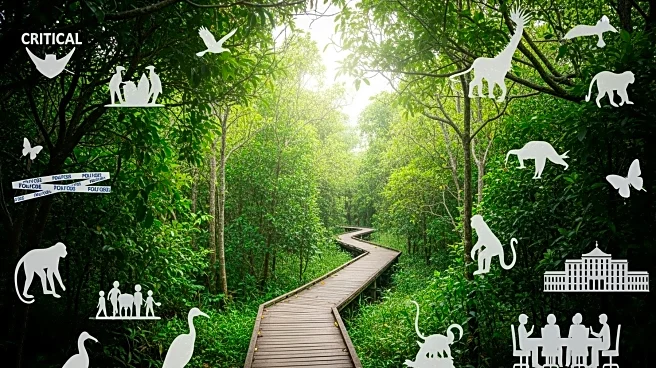What's Happening?
A study conducted by Binghamton University biologists has revealed that arboreal mammals in the Amazon rainforest are using human-made canopy structures, such as elevated walkways, to navigate their environment.
The research, published in the journal Neotropical Biology and Conservation, was carried out at the Amazon Conservatory for Tropical Studies Field Station in Peru. The study involved setting up camera traps to monitor animal activity on these walkways, recording 41 instances of use by species such as sloths, porcupines, opossums, and monkeys. The findings suggest that these structures can serve as safe passageways for tree-dwelling animals, especially as forest habitats become increasingly fragmented.
Why It's Important?
The use of canopy walkways by rainforest animals highlights the potential for these structures to aid in conservation efforts. As deforestation and habitat fragmentation continue to threaten biodiversity, artificial walkways could provide essential connectivity for arboreal species, reducing the risk of mortality associated with crossing roads and other human-made barriers. This research underscores the importance of integrating conservation design into eco-tourism infrastructure, potentially mitigating human-wildlife conflicts and promoting biodiversity. The study's insights could inform future designs of canopy walkways, enhancing their role in preserving rainforest ecosystems.
What's Next?
Future studies may explore seasonal variations in canopy usage and potential changes in species behavior. Researchers aim to refine the design of artificial canopy structures to better support wildlife conservation. As eco-tourism grows, there is an opportunity to incorporate these findings into sustainable tourism practices, ensuring that infrastructure development aligns with conservation goals. Stakeholders in conservation and tourism industries may collaborate to implement these insights, fostering a balance between human activity and wildlife preservation.
Beyond the Headlines
The study raises ethical considerations regarding the impact of human presence on wildlife behavior. While canopy walkways offer benefits, they also highlight the need for responsible tourism practices that minimize disturbances to natural habitats. Long-term, the integration of conservation design into tourism infrastructure could lead to shifts in how eco-tourism is perceived and implemented, emphasizing sustainability and biodiversity protection.













